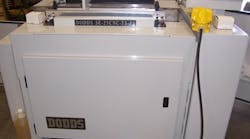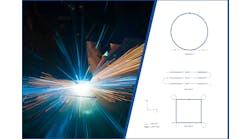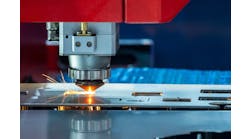Figure 1: This Alexander Dodds dovetailer has made the dovetail joint an industry standard by making the precise joint affordable.
Source: Alexander Dodds
Noted for its superior strength and attractive appearance, the dovetail joint historically was used in only high-end wood furniture and cabinetry because it was labor-intensive when made by hand. In the past few decades, as automated woodworking machines have improved in precision and sophistication, the dovetail joint has become more affordable, and thus an industry standard for cabinet drawers.
Today’s leading manufacturer of dovetailing machines is the Alexander Dodds in Grand Rapids, Michigan. The Dodds SE-1CNC single-spindle dovetailer provides custom style cuts for small- and medium-sized cabinet manufacturers, while the Dodds SE-25CNC multiple-spindle dovetailer cuts standard dovetail styles for customers who need higher production rates (Figure 1).
Figure 2: This two-axis x-y slide assembly makes cutting a variety of dovetail joints, using a programmed motion profile, a quick and repeatable process.
Source: Alexander Dodds
Alexander Dodds provides machinery to produce dovetailed drawers for cabinet manufacturers of all sizes including dovetailers to machine the parts, drawer gluers and drawer clamps to finish off the drawer assembly process. We also design and build custom machines to aid in any part of cabinet construction. We have done drawer notchers, drill machines, face frame assembly machines and cabinet assembly machines, just to name a few.
A dovetailer is an essential tool for cabinet makers to provide high-quality drawer parts, consistently, affordably and at the production rate required. It can be as simple as pulling up preprogrammed part data on the HMI for a customer’s standard parts or inputting custom part data via the HMI. You can run whatever quantity you require, whether it is a standard or custom part.
The challenge
After the U.S. housing bubble burst in 2008, many cabinet manufacturers who relied on new home construction went out of business. During the recent housing market recovery, the remaining cabinet manufacturers have been taking more orders than ever before. With higher demand, these manufacturers are increasing capacity by purchasing additional woodworking machines and upgrading older equipment.
Also read: Panel building advances OEM’s delivery times
In 2012, Alexander Dodds saw an increase in sales of dovetailers to cabinet makers who needed faster turnaround to meet pressing customer demands. Alexander Dodds’ equipment is built to order, so fast machine customization, assembly and delivery is especially challenging.
“Keeping a quick turnaround on an order is essential,” says Jason Tuttle, customer service, purchasing and sales at Alexander Dodds. “The hardest thing is meeting customer demands because they can call today and want it tomorrow. But they also want something customized to stay ahead of the game and out-deliver their competition.”
As Alexander Dodds’ former controls package was slated to end in production, the company began looking for a supplier to simplify its controls package, as well as provide enhanced features. “Our previous controls package had hardware from multiple manufacturers,” says Tuttle. “This required us to make custom cables and use breakout boards, as well as install and maintain multiple pieces of software.”
Updating the technology provided Alexander Dodds with the ability to reduce its machine-building time and improve machine features without increasing costs.
The solution
Alexander Dodds chose to partner with Schneider Electric on all its automation and control needs because working with a single supplier saves them time and money. Previously, the company worked with five suppliers, each requiring their own purchase orders, invoicing and software.
Schneider Electric has a broad spectrum of components from circuit breakers to motion control, so it’s a one-stop shop for us now. Previously, I would submit five to six purchase orders for the components because they were different vendors. The components were more expensive, and the time to enter and process those orders and payments created a lot of hidden costs.
The motion control packages from Schneider Electric are part of the MachineStruxure automation architecture, which provides comprehensive automation solutions for industrial machines based on flexible hardware platforms and SoMachine, a single software suite. Buying components in a package instead of individually is more cost-effective, saving Alexander Dodds $1,000 per machine compared to the old components. The company saves an additional $2,000 per machine by using less wiring and decreasing assembly time.
MachineStruxure hardware and software is offered for machine builders. The hardware and software were selected because it keeps the needs of machine builders in mind. For example, we can reliably and quickly design the machine using pre-built function blocks and protect the intellectual property within the function block. We can also easily change code and programs as the machine's features change, adding and removing functionality.
The design architecture can be chosen, depending on the need. So on a smaller machine, we can choose a smaller controller with smaller I/O. The next time, with a larger machine, we can use a much more powerful controller based on requirements such as a motion-based controller or drive-based controller. Different busses can also be used for communication. All of these abilities are configurable in the same software, and it can be adapted very quickly, depending on the machine needs. Not only is it used on our dovetailer, we use in on the rest of our machines, as well.
What Dodds wanted to do was make the custom machines easier and faster. The more custom machines we can make and the faster we can deliver, the more machines we can sell. Not only was wiring simplified, the design was simplified, making it easier to customize than what it was previously.
Cam motion and woodchips
The dovetailer requires two axes of coordinated motion for the machining of the dovetails. Up to three other individual axes are used for part handling, clamping and positioning. The coordinated motion uses a cam motion profile created using a CNC editor.
The CNC editor resides within the software for the controller. Each motion profile is a subroutine created using the code assist function in the software. The main program is simply calling subroutines to create the motion. It's a recipe management system using G codes and P codes, which the program interprets and controls the drives using CANmotion.
The drives are connected on a CANmotion network, which is more than fast enough for this application, and are connected using plug-in cables minimizing wiring. CANmotion is used to achieve coordinated motion on multiple axes. In addition to the servo drives, some machines use CANopen to connect VFDs, valve stacks and motor starters to the controller for command signals, as well as feedback.
Figure 3: Using remote I/O blocks simplified integration and reduced wiring time.
Source: Alexander Dodds
The networked motion hardware controls an x-y slide assembly, as well as up to three additional axes for side stops to gauge parts on more sophisticated models (Figure 2). The spindle unit and cutters are attached to the x-y slide assembly. Some of the motion profiles include an oval pattern for the male part of the dovetail and a straight plunge cut for the female portion. Speed of 5 in/s, depending on the wood, is controlled on a part-by-part basis by selecting from a range on the part recipe screen in the HMI.
The Modicon LMC058 motion controller installed provides real-time networking capability to the motors and drives. The embedded Ethernet, CANmotion and CANopen provide good options for machine control and future expansion. The digital inputs and outputs are flexible with two to 12 channels for easy expansion and spring terminals that speed up wiring times.
Sensors were connected using the Modicon TM7 IP67 remote I/O blocks. Connections included two sensors on each axis for home and overtravel sensors, foot pedals and miscellaneous sensors. Networking to these blocks limits the number of wire connections that need to be made. A CANmotion connection to an SMC five-station valve bank eliminated wiring and relays, common in previous controls packages to change from sinking to sourcing or vice versa, to allow Alexander Dodds to connect devices from different manufacturers. These network connections only require power and the network connection.
Simple and fast
With the embedded Ethernet connection to the HMI, we do not experience the processing lag time we had with serial connections. Embedded Ethernet allows for faster transmission rates between the controller and the touchscreen. One Alexander Dodds customer using a new dovetailer reports the ability to produce an additional 100 cabinet drawers per day because of the performance of the new controller.
The HMI was a necessary component to enable customers to store and edit parts. It also displays faults and machine status. There are maintenance screens to view I/O to aid in troubleshooting, if required. Alexander Dodds dovetailers feature the Magelis STU855 HMI with touchscreen panel. The HMI synchronizes with the Modicon controller, so any updates to the controller are automatically loaded to the HMI.
Another timesaver is that the HMI is mounted using a 22-mm pushbutton hole. Just drill and punch a hole, instead of the rectangular cutout often required. When we install the HMI, we don’t have to do a big panel cutout in the enclosure. It saves me a couple hours per machine to not do a cutout anymore, and the HMI mounts quickly to our machines.
In the event that the HMI screen is damaged, an optional app for the Magelis HMI, Vijeo Design Air, can allow for remote control of the dovetailer from an iPad device, Android smartphone or tablet, significantly reducing downtime. “This has been a big selling point for us,” says Tuttle. “One of our customers had an employee break an old HMI screen and lost $8,000 in revenue because the machine was down for two days. If they’d had a new dovetailer with the Magelis HMI, they could have been up and running again in five minutes using a tablet or smartphone while the screen was being replaced. It gives our customers peace of mind to have this feature.”
It's not standard equipment, but the ability is there to do it. It doesn't take much more than selecting a check box when you download the program. You can use the option if you install a wireless router. By connecting the HMI and controller through a wireless router, a customer can use the Vijeo Design Air app on a smartphone or tablet and have the same functionality as they did with the HMI.
Less wiring speeds up assembly time
Thanks to the Schneider Electric components, wiring costs on the Alexander Dodds dovetailers have been reduced by one-third, and wiring time for assembly is 15 hours shorter, which cuts delivery time by about one day.
Figure 4: Efficient hardware design reduced panel-space requirements and wiring and simplified troubleshooting.
Source: Alexander Dodds
The Lexium 23 servo drive has significantly reduced wiring on the dovetailers because the drives can be daisy-chained together with a single cable connecting one drive to another. The drives are equipped with basically an in and out port for the CANopen connections. With purchased cables from Schneider, you would run a CANopen cable from the controller to the in on the first drive and then a cable from the out on the first drive to the in on the second drive and so on. Power for the drives and motors are wired separately.
The use of the Modicon TM7 modular remote I/O system reduced wiring time. The old dovetailers had 24 wires connecting to eight sensors. With the remote I/O, there were only six wires between the remote module and the controller. Less wire means shorter wiring times and less wire costs and also reduces the need for terminals and relays. Alexander Dodds reduced the wiring terminals in the main control panel from 79 to 12 and completely eliminated the need for relays.
The Modicon TM7 remote I/O blocks connect to the controller with a four-wire communication cable that’s inserted into spring terminals on an expansion module that is attached to the end of the controller (Figure 3). Twenty-four Volts positive and negative are run from the supply terminals to the I/O block and then distributed by the block.
The wiring time is the big gain—it's simplified. The amount of time saved by making quick connections to the drives and sensors is the biggest benefit. We used to sit there for hours and make cables, breakout boards and terminal connections. It saves so much time by having the plug-and-play aspect of this hardware architecture.
[sidebar id=5]
There are fewer chances of small wires coming loose and causing issues with Dodds’ dovetailers, says Tuttle (Figure 4). “One of our customer’s head of maintenance looked in our dovetailer cabinet and couldn’t believe how empty it was, especially considering the number of servos there are,” he explains. “He said to me, ‘You just made my job easier.’ Now, many customers can use in-house staff to troubleshoot without calling in an electrical specialist.”
Single software simplifies troubleshooting
The SoMachine software on all the Schneider Electric motion control components is easily downloadable to the controller and HMI from a single USB port, reducing machine programming time. If an Alexander Dodds customer needs to make updates to the machine program, Alexander Dodds sends an updated program via email, and the customer can load it directly with a jump drive and have the equipment up again in as few as five minutes.
The SoMachine software is the development environment for the controller, HMI, servo drives and valves. Lay it out and program it from a single program using IEC 61131 programming languages. It’s got recipe management, G-code motion profiles and protection of intellectual property all in the same package. By using this single software, Alexander Dodds and its customers no longer need to buy or renew software licenses for multiple pieces of software each year. The SoMachine software updates automatically.
In our old system, we used five different pieces of software from three component manufacturers. It was a challenge to get the software to work together, which required another piece of software. Using a single software helps us to stay competitive.




